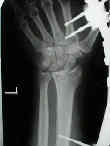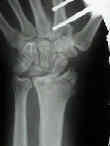- Discussion:
- longitudinal traction restores skeletal length and improves fracture alignment,
- radial styloid frx and scaphoid facet are usually amenable to reduction through ligamentotaxis or by manipulation and reduction with a large, pointed bone clamp;
- residual incongruity usually involves the lunate facet of the distal end of the radius;
- Cautions:
- excessive longitudinal traction may have the effect of increasing dorsal tilt as distal fragment pivots on taut dorsal soft tissue hinge;
- most fixators use only longitudinal traction forces that are incapable of restoring palmar tilt;
- dorsal capsule has no ability to maintain reduction by ligamentotaxis;
- dorsal ligaments run obliquely and tend to stretch apart rather than exerting equivalent force to ditsal fragment from external fixator;
- Case Example:
- radial styloid fragment of this distal radius fracture, did not reduced despite ample ligamentotaxis from an external fixator;
- percutaneous pins were required to complete the reduction



